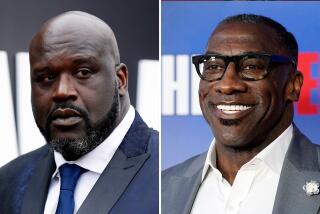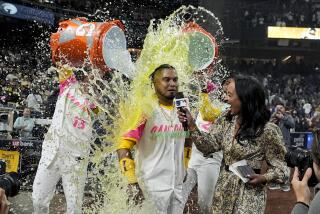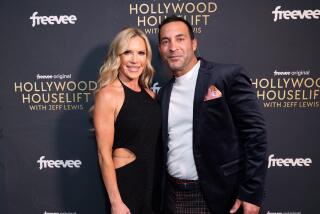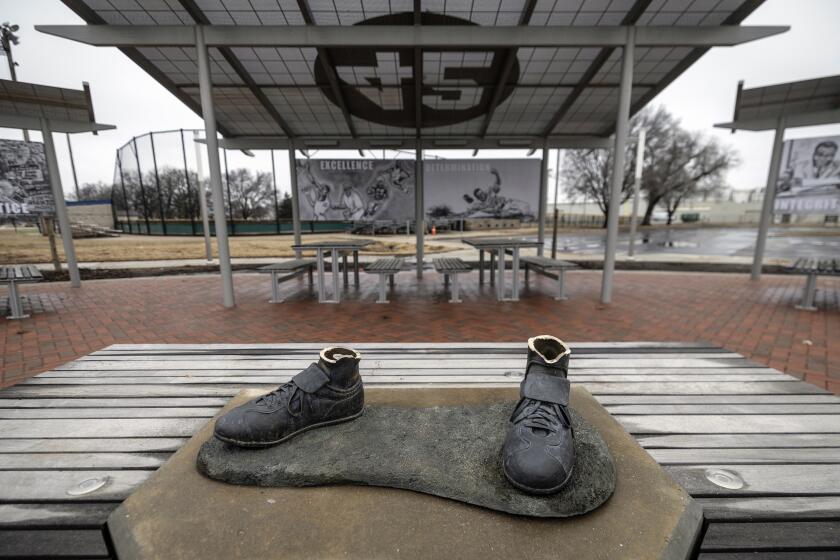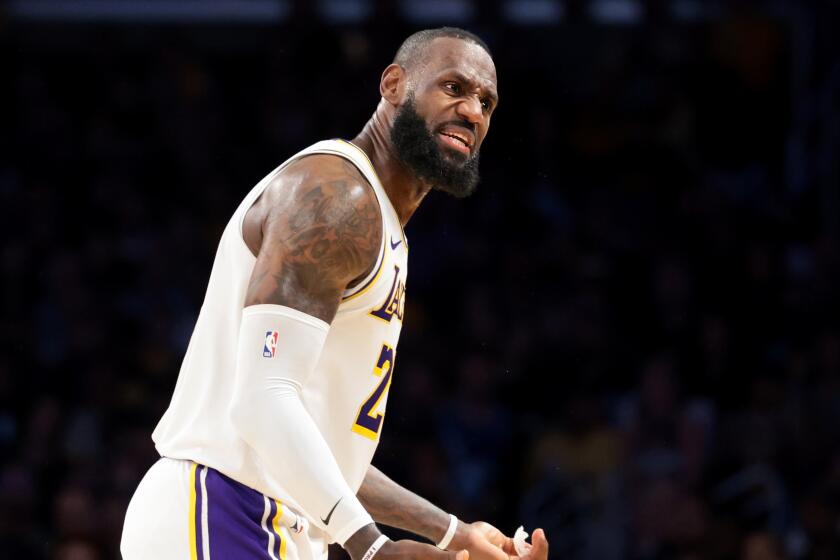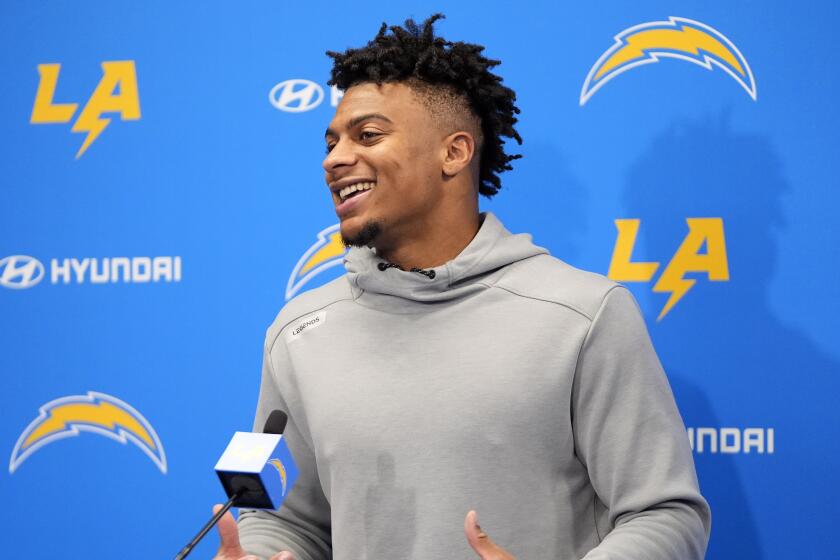49ers Strike Gold Again
For San Francisco, the 21st century is beginning to look like the 20th, in which the 49ers kept winning games and setting records with quarterback Joe Montana, wide receiver Jerry Rice and running back Roger Craig.
If the 49ers beat 1-8 Carolina today, they will be 7-2 for 2001 with their three new aces, quarterback Jeff Garcia, wide receiver Terrell Owens, and running back Garrison Hearst.
The 49ers have become an extraordinary team. Unlike all other NFL franchises, the 49ers have, for 21 years, come up with winning quarterbacks from Montana to Steve Young to Garcia; with winning wide receivers from Dwight Clark to Rice to Owens, and with winning ballcarriers from Craig to Ricky Watters to Hearst.
They have found these players everywhere from the third round in the draft (Montana) to San Jose State, where, if Garcia got a Heisman Trophy vote as a senior, it was his own. Nobody in the NFL wanted Garcia in 1999. Not even the 49ers, it seemed for a while.
They do now.
Walsh’s 14 Players
The link from 1981 to 2001 is Bill Walsh, who was their coach when the 49ers started stockpiling a record five Super Bowl victories; who was their general manager through their most recent player drafts, and who still maintains an office at 49er headquarters as their most valuable advisor.
By no means did Walsh find all of their winning players. He may not, personally, have found any. But his is the philosophy and his are the standards and policies, as applied for two decades, that have made San Francisco the NFL’s greatest modern success story.
Asked the other day what it takes to be a football winner, Walsh said, “You need 14 very good players--11 on defense and three on offense. You can coach the others.”
The 49ers, that is, can find the 14 and coach the others. It’s plainly easier said than done. Check the NFL standings for the names of this year’s mediocre and losing teams, many of whom have struggled for much of the time through the age of the 49ers.
One difference in San Francisco--one reason the 49ers could hold off New Orleans last Sunday, 28-27--is that Walsh and his accomplices have focused in the right areas. They are always looking for a Steve Young or a Jeff Garcia, for a Rice or an Owens or a Hearst.
They brought in 54 rookies and other first-year players this year--more than any other NFL team had and twice as many as some NFL teams inspected at mini-camp. The 49ers are always mining for gold.
Polish, Discipline
For every team in the NFL, the future is everlastingly jammed with uncertainties and hazards. On the best pro clubs, as in the best-run nations, succession is always chancy. The next king, the next president--will he ruin us?
In Green Bay, there was nothing but darkness for years after Vince Lombardi resigned.
In San Francisco, by contrast, after Walsh’s three Super Bowls, there were two more Super Bowls with his successor, George Seifert--who, significantly, can’t win on his own at Carolina (though he wants revenge today). And for five years now, the 49ers have had Steve Mariucci--their third consecutive winning coach. That’s outstanding.
Mariucci’s team was noticeably more polished and disciplined than the New Orleans team last Sunday, even though, overall, it might not have been as talented. On another big day for Garcia, the 49ers won by throwing touchdown passes on first down--once to a rookie named Kevan Barlow, a third-round draft choice from Pittsburgh who might become the finest running back they’ve ever had.
On his biggest play, Barlow gave Garcia’s short throw a remarkable 60-yard ride through heavy traffic as slower Saints bounced off him.
Besides that and three other scoring passes by Garcia, there were 145 yards rushing by Hearst and 100 receiving by Owens.
Garcia, Owens, Hearst? Or Montana, Rice, Craig? Who could tell?
Donahue Next
The two leaders who, down the road, will mean the most to the 49ers are Mariucci and Walsh’s handpicked successor as general manager, Terry Donahue.
This is Donahue’s first year in charge, meaning he’s an unknown quantity. But based on his time in Los Angeles, where he coached UCLA for so many years, he has one important thing going for him: Donahue is and is sure to remain the most personable executive in the league.
There are bound to be instances when that will mean something good for the 49ers--some new players and/or others who will choose the 49ers over their competitors in a league that, unhappily, isn’t devoid of mean-spirited leaders.
Still another San Francisco asset is the West Coast offense--which more exactly should be called the Bill Walsh offense, after the coach who designed it. Although more than half of all pro clubs now embrace some form of the West Coast, Mariucci’s team gets it from the horse’s mouth.
“The thing to remember about the so-called West Coast is that it changes every year,” Walsh said. “I used to change it every year myself. Also, it’s different everywhere every year. Basically, the [offense] is nothing more than the approach you take to football, the whole approach. Watching us play, a spectator can’t really recognize it except there may be more crossing patterns, more draw plays, more play-action passes, more first-down passes.”
Conservative Saints
The Saints are an example of the many NFL teams that look at the world around them different from the 49ers. Accordingly, as Garcia won with first-down passes last Sunday, the Saints wasted most of their first-down plays trying to run the ball with Ricky Williams.
That strategy repeatedly left Saint quarterback Aaron Brooks in second-or third-down predicaments. Thus, Brooks is getting blamed for failures that should be ascribed to his coach, Jim Haslett, a conservative who’d rather wear you down with Williams than throw over you with Brooks. And so his players are 4-4 after losing four times to ballclubs they were good enough to beat: Atlanta, San Francisco, and the two New York teams.
The Saints are better than all four.
Bears Destruct
Something like the Saints’ first-down strategy by the Chicago Bears, once more, could beat them, again once more, at Raymond James Stadium in Tampa Sunday, when the Buccaneers should win another dull battle of twin conservatives because they’re slightly more talented.
The Bears, however, could have put up more of a fight than they did against Green Bay last Sunday.
In a game they lost, 20-12, the Bears played for field goals, four of them, as quarterback Brett Favre went for touchdowns, two of them, scoring both times on passes to save the Packers.
Though not impressive against the rebuilding young Chicago defense, the Packers proved again that other teams may shut out a good passer like theirs the vast majority of the time but not all the time.
As for the Chicago offense, the Bears seem fascinated with their excellent new running back, Anthony Thomas, to whom they handed the ball continually to run up a 6-0 lead in the first quarter--on two field goals.
Meantime, when the game was on the line, the Bears stuck with very short passes or no passes by Jim Miller, who, although no Favre is a much better quarterback than some say.
In a capsule of the game, the Bears in the second quarter ran Thomas on three successive plays and then punted to the Packers, whose quarterback promptly threw to receiver Bill Schroeder on a 41-yard touchdown play.
That didn’t end the game; but when the Bears kept running Thomas in the third quarter, most conspicuously on failed first-down plays, it ended soon enough.
This was a game that could have held few spectators enthralled.
Introducing a new NFL contender to the country on national television, the improving Bears identified themselves as one of the NFL’s 25 or more run-of-the-mill, let’s-play-defense, let’s run-the-ball teams.
The Rams are different. The 49ers and Raiders are different. The Indianapolis Colts and many others could be different, but most NFL coaches are, as they often say themselves, like sheep, and their fans have to pay for that.
More to Read
Get our high school sports newsletter
Prep Rally is devoted to the SoCal high school sports experience, bringing you scores, stories and a behind-the-scenes look at what makes prep sports so popular.
You may occasionally receive promotional content from the Los Angeles Times.
